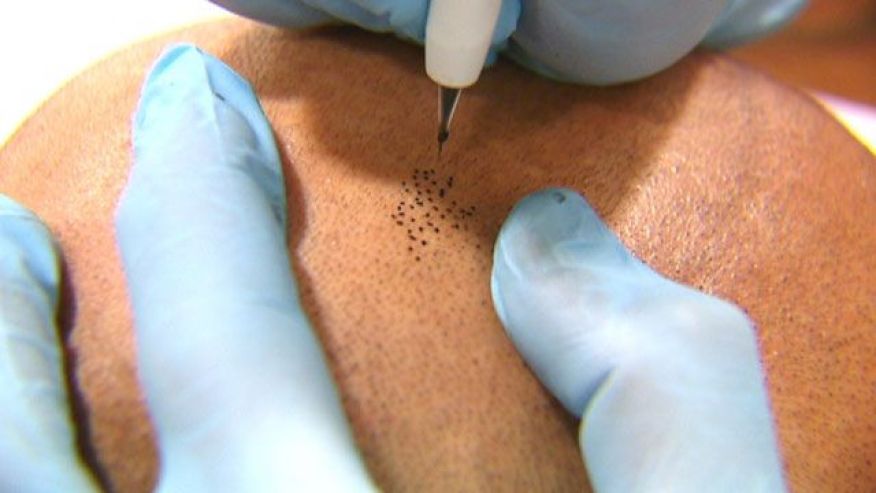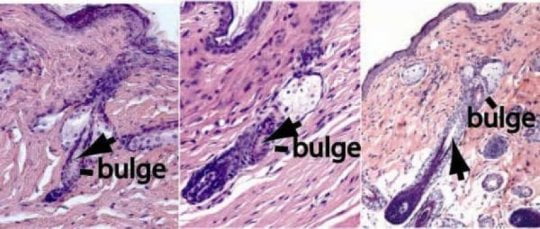
The cornea—the clear lens at the front of eye—is the part of the eye most vulnerable to trauma in animals. Dogs with flat faces and bulgy eyes, such as bulldogs and pugs, are especially prone to bumping into things and accidentally scratching their corneas.
Corneal injuries and disease can escalate quickly, often leading to the loss of the eye or the need for extensive and possibly scarring surgery in animals. Recently, though, veterinary ophthalmologists at Cummings Veterinary Medical Center have started using corneal crosslinking—a treatment borrowed from human medicine—to help spare animals’ eyes or avoid surgery.
Corneal crosslinking was developed to treat a condition called keratoconus in people, said veterinary ophthalmologist Stephanie Pumphrey, an assistant professor at Cummings School. In this condition, the cornea is not quite rigid enough, so it droops—changing the cornea’s shape. This affects a person’s vision because the cornea no longer focuses light the way it’s supposed to, said Pumphrey.
A corneal transplant was once the only way to restore sight in people with keratoconus. Then researchers discovered that they could bolster a sagging cornea by applying eye drops of riboflavin—a bright-yellow B vitamin—and then exposing the eye to ultraviolet light.
“The riboflavin absorbs the light and produces energy,” Pumphrey said, “and that energy affects the surrounding collagen, which is the protein that makes up most of the cornea.” Collagen fibers in the cornea end up binding to the ones next to them, “forging these strong crosslinks”—hence the name of the therapy.
The result is that the cornea becomes a lot more rigid, said Pumphrey. “If you take a piece of cornea that’s not crosslinked, it’s floppy—like a boiled spaghetti noodle,” she said. “But a crosslinked piece becomes stiffer, like an uncooked noodle.”
Animals don’t get keratoconus, but a handful of veterinary practices across the country are using the crosslinking approach to treat animals with corneal ulcers or infections.
The only veterinarians offering the therapy in New England, Tufts ophthalmologists use corneal crosslinking most often in treating dogs and horses with “melting” ulcers. In this eye condition, a wound to the cornea ends up causing the surrounding tissue to start to break down. “There’s usually a green or yellow look to the cornea and the tissue is just sort of dissolving in front of your eyes,” Pumphrey said.
“If we use crosslinking, we can stabilize those corneas quite nicely and stop that process in its tracks,” she said. “It helps us save eyes that we’d otherwise be unable to, and it also can get pets off medications sooner, which can be a big help for pet owners.”
Crosslinking may also improve surgical options for some animals. A severe ulcer usually requires surgery to patch the cornea. Typically, grafts are taken from the opaque whites of the eyes. That’s because, unlike corneal tissue, it has lots of blood vessels, which a transplant needs to successfully integrate with a cornea under the assault of a melting ulcer. But since crosslinking helps makes the corneal tissue resistant to degradation and has antibacterial and antifungal effects, it allows veterinarians to use more desirable, transparent grafts instead.
Animals undergoing crosslinking usually only require sedation, although some are briefly put under general anesthesia, particularly if there’s damaged tissue that needs to be removed. Pumphrey reported that this aspect of crosslinking can especially improve care for eye problems in Cummings School’s largest patients.
“With horses, we worry a lot about anesthesia because things can always go wrong when you’re dropping a horse and having it get back up again,” Pumphrey said. “But we often can do crosslinking as a standing procedure in horses, which eliminates those risks.”
[“source=tufts”]



















